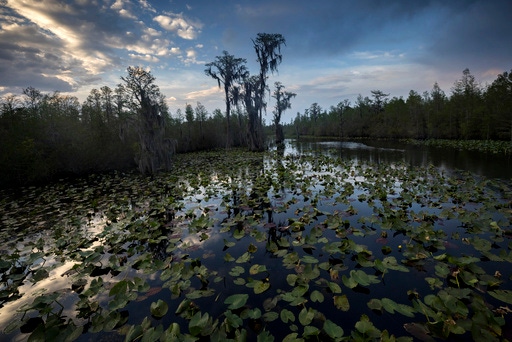Agency approves expanding Okefenokee wildlife refuge, setting up possible buyout of mining project

FILE - The sun sets over water lilies and cypress trees along the remote Red Trail wilderness water trail of Okefenokee National Wildlife Refuge, Wednesday, April 6, 2022, in Fargo, Ga. (AP Photo/Stephen B. Morton, File)[ASSOCIATED PRESS/Stephen B. Morton]
SAVANNAH, Ga. (AP) — A federal agency said Friday that it has approved a plan to expand the Okefenokee Swamp’s vast wildlife refuge, setting up a potential buyout offer for land intended for a private company’s mining project that conservationists have fought for years.
The plan approved by the U.S. Fish and Wildlife Service could add 22,000 acres (8,900 hectares) along the boundaries of the Okefenokee National Wildlife Refuge, the largest federal refuge east of the Mississippi River. The service manages the refuge and is part of the Interior Department.
“This minor expansion will help further conservation efforts for the swamp along with the threatened and endangered species that inhabit it,” Michael Lusk, the Okefenokee refuge manager, said in a news release.
Owners of private land included in the expansion plan would first have to agree to sell or donate their property to the federal government. That includes land owned near the swamp’s edge by Twin Pines Minerals, which is on the cusp of obtaining state permits to mine minerals for producing titanium dioxide. The compound is used to whiten paints, paper and toothpaste.
Scientists have warned that mining near the Okefenokee’s bowl-like rim could irreparably harm the swamp’s ability to hold water and increase the frequency of withering droughts. Interior Secretary Deb Haaland in 2022 declared that the proposed mine poses an “unacceptable risk” to the fragile ecosystem at the Georgia-Florida line.
The Fish and Wildlife Service adopted the expansion plan after a public comment period on the proposal the agency first announced in October.
The proposal comes as Twin Pines awaits final approval from Georgia environmental regulators of its mining project less than 3 miles (4.8 kilometers) from the refuge’s current boundary.
Josh Marks, an Atlanta environmental attorney who opposes the Twin Pines project, called the refuge expansion plan “a critical development in the drive to protect the Okefenokee Swamp from mining.” He called on Georgia officials to deny permits for the mine in hopes that Twin Pines would “donate or sell its property for conservation.”
Steve Ingle, Twin Pines’ president, had no comment on the federal agency’s announcement Friday, spokesman Chip Stewart said.
An attorney for Twin Pines, Lewis Jones, wrote to the Fish and Wildlife Service last month that the company would “take FWS at its word” that it would only “acquire property from willing sellers” and not use the expansion plan to try to influence the state permitting process.
Twin Pines, which first applied for permits in 2019, has insisted that it can mine near the Okefenokee refuge without harming it.
The Georgia Environmental Protection Division issued draft permits for the project in February, after state regulators said their own analysis “concluded that water level in the swamp will be minimally impacted.”
Final permits are still pending that would authorize Twin Pines to mine on 773 acres (312 hectares). The company owns roughly 7,800 acres (3,150 hectares) outside the refuge boundary and has said it would likely seek to expand its mining operation in the future.
The Okefenokee refuge covers nearly 630 square miles (1,630 square kilometers) in southeast Georgia and is home to more than 400 animal species, including alligators and bald eagles. The swamp’s wildlife, cypress forests and flooded prairies draw roughly 400,000 visitors each year, according to the Fish and Wildlife Service, which manages the refuge.
Typically, the U.S. Army Corps of Engineers would also need to approve permits. But it lost that authority over the Georgia project in 2020 because of regulatory rollbacks under then-President Donald Trump.
The planned refuge expansion comes in the waning days of Joe Biden’s presidency, raising the possibility that it, like other executive actions on the environment, could be undone once Trump is sworn back into office this month.
Copyright 2025 The Associated Press. All rights reserved. This material may not be published, broadcast, rewritten or redistributed without permission.